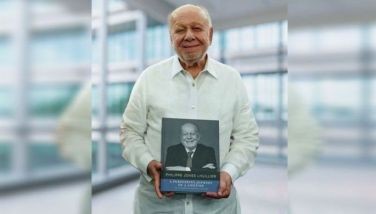World Bank fills void in funding for peace and development in ARMM
June 13, 2006 | 12:00am
COTABATO CITY — The World Bank, through the Autonomous Region in Muslim Mindanao (ARMM) Social Fund Project (ASFP), is building schools, farm-to-market roads, health centers, post harvest facilities, water systems and other projects designed to improve the productivity of farmers in impoverished areas in the region.
The ARMM covers Marawi City, Maguindanao and Lanao del Sur, which are both in Central Mindanao, and the island provinces of Basilan, Sulu and Tawi-Tawi.
Many projects of the ASFP, operating under a "tripartite cooperation scheme" between a joint team from the ARMM’s executive department and Malacañang and the World Bank, are located in areas where Muslim secessionist rebels reside.
For accountant-lawyer Arnel Datukon, project manager of ASFP, the loan grants from World Bank, which are complemented with a counterpart package from Malacañang, are a big help to the administration of ARMM Gov. Datu Zaldy Ampatuan.
"We ought to thank the World Bank for the loan which is now being spent for ASFP projects, which we are implementing to improve the lives of ARMM residents and, at the same time, complement the Southern peace process," Datukon said.
He added that the national government, under the loan agreement, will pay the World Bank, but under a very long repayment period. Camar Macapodi, a farmer in Barangay Sarang, a hinterland community in Malabang, Lanao del Sur, said the ASFP, using World Bank money, has made their work easier by constructing long trails, called "tire paths," which make it convenient to haul farm products to their town center. The trail interconnects their highland villages to the national highways.
"Our income increased three-fold because we can now deliver our harvests to the markets right away. Our products don’t get stalled anymore or, during the rainy days, even rot in the farms because of the difficulty of bringing them to the town proper," Macapodi told The STAR in the Maranaw dialect.
Rice and corn farmers in Barangay Narra in Sultan Kudarat, a town in the first district of Maguindanao, now have a communal solar dryer and a 10-ton warehouse for their grains, which the ASFP built for them.
The administrations of Zacaria Candao and Lininding Pangandaman, the first and second governors of ARMM, respectively, were blessed with a five-year P615 annual infrastructure "seed money" which they spend for their projects in the old autonomous region, which then covered only Maguindanao, Lanao del Sur, Sulu and Tawi-Tawi.
Thanks to the World Bank and other foreign donors, such as the United States Agency for International Development (USAID) and the European Union, the executive department of ARMM has continued reaching out to poor sectors in the region through small infrastructure projects.
Ampatuan told newly installed US Ambassador Kristie Kenney during a meeting in Manila that because of the USAID projects in the autonomous region, trade and industry in ARMM has improved. In other areas, the World Bank permitted the ASFP to construct water systems as part of the effort to eradicate water-borne diseases such as cholera, and to enable farmers to irrigate their backyards where they can raise vegetables and engage in small-scale poultry projects.
The ARMM covers Marawi City, Maguindanao and Lanao del Sur, which are both in Central Mindanao, and the island provinces of Basilan, Sulu and Tawi-Tawi.
Many projects of the ASFP, operating under a "tripartite cooperation scheme" between a joint team from the ARMM’s executive department and Malacañang and the World Bank, are located in areas where Muslim secessionist rebels reside.
For accountant-lawyer Arnel Datukon, project manager of ASFP, the loan grants from World Bank, which are complemented with a counterpart package from Malacañang, are a big help to the administration of ARMM Gov. Datu Zaldy Ampatuan.
"We ought to thank the World Bank for the loan which is now being spent for ASFP projects, which we are implementing to improve the lives of ARMM residents and, at the same time, complement the Southern peace process," Datukon said.
He added that the national government, under the loan agreement, will pay the World Bank, but under a very long repayment period. Camar Macapodi, a farmer in Barangay Sarang, a hinterland community in Malabang, Lanao del Sur, said the ASFP, using World Bank money, has made their work easier by constructing long trails, called "tire paths," which make it convenient to haul farm products to their town center. The trail interconnects their highland villages to the national highways.
"Our income increased three-fold because we can now deliver our harvests to the markets right away. Our products don’t get stalled anymore or, during the rainy days, even rot in the farms because of the difficulty of bringing them to the town proper," Macapodi told The STAR in the Maranaw dialect.
Rice and corn farmers in Barangay Narra in Sultan Kudarat, a town in the first district of Maguindanao, now have a communal solar dryer and a 10-ton warehouse for their grains, which the ASFP built for them.
The administrations of Zacaria Candao and Lininding Pangandaman, the first and second governors of ARMM, respectively, were blessed with a five-year P615 annual infrastructure "seed money" which they spend for their projects in the old autonomous region, which then covered only Maguindanao, Lanao del Sur, Sulu and Tawi-Tawi.
Thanks to the World Bank and other foreign donors, such as the United States Agency for International Development (USAID) and the European Union, the executive department of ARMM has continued reaching out to poor sectors in the region through small infrastructure projects.
Ampatuan told newly installed US Ambassador Kristie Kenney during a meeting in Manila that because of the USAID projects in the autonomous region, trade and industry in ARMM has improved. In other areas, the World Bank permitted the ASFP to construct water systems as part of the effort to eradicate water-borne diseases such as cholera, and to enable farmers to irrigate their backyards where they can raise vegetables and engage in small-scale poultry projects.
BrandSpace Articles
<
>
- Latest
- Trending
Trending
Latest
Trending
Latest
Recommended





























